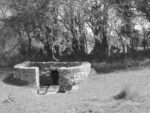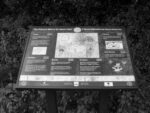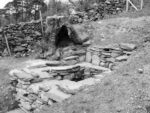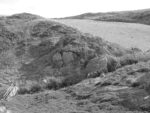Janet Bord considers the development of holy well research and interest through the lens of her work in Wales
 Davina Ware
Davina Ware
Little did I know what I was letting myself in for when I started researching the book which was published in 1985 as Sacred Waters: Holy Wells and Water Lore in Britain and Ireland. I began the project as a novice in the field of holy wells, but became fascinated by them as the book progressed – though I never would have guessed that 30 years later I would still be involved with them. Among numerous statements in Sacred Waters which I would now raise an eyebrow at, the one which had the most far-reaching effect was the bizarre statement, with reference to holy wells in Wales, that ‘We have discovered relatively few surviving wells… and should be glad to learn of others not mentioned below.’ Spurred into action on reading this sentence, Tristan Gray Hulse wrote me a long letter explaining very kindly just how wrong I was. As a result of his gentle admonition, we became firm friends and have been visiting Welsh holy wells together ever since.
I have published two further books on holy wells: Cures and Curses: Ritual and Cult at Holy Wells (2006) and Holy Wells in Britain: A Guide (2008). Having got those out of my system, I have for the last few years been concentrating exclusively on researching saints’ wells in Wales – of which at the last count there appeared to be around 650. I decided to restrict my research specifically to saints’ wells, i.e. those named for saints, since the term ‘holy wells’ has widened so much that it now seems to encompass most named wells, regardless of whether there was any religious impulse behind their creation and usage.
There are probably thousands of wells and springs throughout Wales, since until relatively recently everyone obtained their water from these sources. But they were created for practical reasons, whereas wells named for saints had a more spiritual raison d’être, often being features within sacred landscapes dedicated to specific saints, and also often being resorted to in search of cures, with the sufferer appealing to the saint for healing.
Since the 1950s the ‘Bible’ for Welsh well enthusiasts has been Francis Jones’ invaluable book The Holy Wells of Wales. Unfortunately, however, too many people regard this book as infallible, which it certainly is not. When I started my own project on Welsh wells I too revered Francis Jones, and to an extent I still do. He was the first person to collect together data on hundreds of named wells in Wales, and his book is a useful starting-point. He divided the wells within each county into five classes, with Class A being wells named for saints, through to Class E, miscellaneous wells. Laudable though his plan was, his listings are unreliable because there are so many errors. Class A contains many wells that are not saints’ wells, other classes contain wells which should be in Class A, and Classes D (wells named for secular people) and E (miscellaneous wells) are outside the scope of a book on ‘holy’ wells. Admittedly he notes that Class D may include wells named for ‘minor or local saints’, and I agree that it’s not always easy to identify these, but it would have been better to have a category for possible lost saints.
Like Jones, I have on occasion found difficulty in deciding whether some wells were named for saints or not, even though research into obscure Welsh saints has improved immeasurably since Jones’s time. The existing data concerning Welsh saints is so fragmented, and often contradictory, that only a few specialist researchers are able to make sense of it, and I am definitely not one of them. Unfortunately most published accounts of Welsh saints contain inaccuracies. Anyone wishing to delve more deeply into this subject should consult Peter C. Bartrum, A Welsh Classical Dictionary: People in History and Legend up to about A.D. 1000 (Aberystwyth: The National Library of Wales, 1993), which is also now available online: www.llgc.org.uk/collectionsdigital-gallery/printedmaterial/a-welsh-classical-dictionary/ Even though his book is now more than 20 years old, his conclusions with regard to the more contentious and/or elusive saints are still mostly to be relied upon.

The Virtuous Well, also known as St Anne’s Well, at Trellech in Monmouthshire, photographed in 2009. These days the bushes behind it are always festooned with rags left by visitors.
Many people who write about Welsh holy wells tend to copy what other people have said and do not bother to go back to original sources. It is quite surprising how many errors can be picked up if one takes the trouble to start again at the beginning. Detective work is involved, and it’s also vital never to assume that what others have published is accurate. Even the best historians can make mistakes – and I am not immune either! But it is very satisfying to dig out new information and to reinterpret existing information. These days historical researchers have access to sources via the computer that could not even have been dreamt of 30 years ago, and although I have reservations about some aspects of the computer age, I have to admit that it has been a god-send for researchers.

The fairy-infested information board beside the Virtuous Well (St Anne’s Well) at Trellech in Monmouthshire is a masterpiece of misinformation.
I have reached conclusions on some wells that I never expected when I started looking into the published ‘facts’. There are some wells now bearing saints’ names which research has shown were never dedicated to saints at all. One good example of this is a stone well-like structure close to Llanmihangel church in Glamorgan. Before the late 19th century this ‘well’ was unnamed, but for the last century it has been known as St Anne’s Well. It sports an unusual feature for a holy well, the bust of a woman from whose breasts water used to flow, and it is probably this feature which led someone to identify her as St Anne. There isn’t space here to describe all my detective work on this ‘case’, but my conclusion was that the structure was probably never a holy well at all, but simply a water feature in the orchard of Plas Mihangel, the mansion across the road, in whose historic garden is another similar water feature also with the figure of a woman with holes for nipples, possibly created in the 16th or 17th century.
There is another wrongly-named St Anne’s Well at Trellech in Monmouthshire, now much visited and well maintained, but with a changing history. It seems to have started off as a medicinal well in the 17th century, known as the Virtuous Well, and like the ‘well’ at Llanmihangel has only been called St Anne’s Well for the last 100 years or so. During that time it has also developed an intriguing folklore, involving fairies, making wishes, and so on, all totally fanciful. Even since I first visited the well in 1976 the aura of the site has changed. At that time only a few small flower offerings were seen, and there were no rags hanging in the bushes above the well, as there always are today. The subtly changing nature of this well from a ‘medicinal mineral water’ in the late 17th century, to a healing spa, to a saint’s well, to a fairy haunt, and finally in the early 21st century to a fully-fledged New Age shrine, is a classic example of how wells can change and develop over the years, decades and centuries as the expectations of visitors change.
It is also surprising how many saints’ wells have been lost, with their former existence only being revealed in, for example, field names from the 16th, 17th or 18th centuries. A name like Cae Ffynnon Fair, for example, indicates a field (cae) named for Our Lady’s Well, a sure indication that the field once contained such a well. Sadly, quite often no other information can be located, so that we will never know when, why or how a well was created there, who visited it, what healing qualities the water was believed to have, and so on. Sometimes passing references to named wells can be found, often in obscure books of local history or travellers’ accounts from past centuries, showing their popularity in former times. These are some of the sources that can now be consulted much more easily since the advent of the internet.

The newly restored well of St Gwyddelan at Dolwyddelan, Caernarfonshire, photographed in the spring of 2015
My use of Ffynnon Fair as an example of a well name reminds me to mention another discovery: that wells known as Ffynnon Fair (St Mary’s Well) were not necessarily specifically named for that saint. There are at least 100 St Mary’s wells in Wales, but it seems that very few were consciously dedicated to her. This may seem like a strange statement to make, but I have seen enough references to ‘Ffynnon Fair’, usually in guide books of the 18th and 19th centuries, to realise that this was at one time used as a generic term to mean simply ‘holy well’. For example, the Reverend J. Evans, in his book about his tours through North Wales in 1798, referred to St Peris’s Well (Ffynnon Beris) as ‘A Ffynnon vair or holy well…’
In addition to all the wells named Ffynnon Fair, I am also researching wells named for almost 250 individual saints, most of them native Welsh saints, with obscure names such as Tewdric, Sulien, Rhedyw, Mordeyrn, Tyssilio and Ieuan Gwas Padrig. These early saints did not become saints in the way that we are familiar with today, but were simply regarded as saints by their local congregations, were revered by them, and were sometimes buried in a special capel y bedd (grave chapel) added to their church. Relics in the form of bones or something owned by the saint were often kept in a box or reliquary that could be carried around in ceremonies; and often a sacred landscape grew up in memory of the saint, with sites where he or she was revered, such as a well, and other landscape features named as the saint’s bed, chair, etc. There were sometimes legends explaining how a well was created, perhaps at the place where the saint was beheaded, or martyred: life for them was not all plain sailing, and there was plenty of conflict as they tried to spread the Christian faith.

Modern window depicting St Winefride (Gwenfrewy) and St Beuno at St Winefride’s Well, Holywell, Flintshire
The most famous story of a beheading is that of St Gwenfrewy (now more usually known as Winefride), a young girl who was beheaded at Holywell in Flintshire by a thwarted suitor. Fortunately her uncle Beuno was close at hand and was able to reattach her head so that she made a complete recovery, except for a thin line around her neck as a permanent reminder of what had happened to her. A well also sprang up where her head had fallen, which over the centuries grew in fame until it became, and probably remains, the best known and most visited holy well in Britain. Visually, St Winefride’s Well is almost certainly the most complex of the Welsh saints’ wells, being contained within a impressive stone building with a chapel above, and having a large outdoor bathing pool. People still bathe in hopes of a cure, often following the centuries-old ritual procedures.
At the other extreme, of course, is the ‘well’ which is now nothing more than a barely discernible damp patch in a field, once a spring but long since overgrown. Holy wells are rarely wells in the sense of a shaft that has been sunk into the ground in order to tap into a water supply. They are usually simple springs, which are sometimes made more elaborate with stone structures such as a small pool, which may be big enough to allow for whole or partial immersion. In Wales the term ffynnon is usually used which can mean spring, fountain or well; sometimes pistyll is used instead, but this means waterfall as well as spring, and so is more likely to be used when a spring is visually reminiscent of a small waterfall. Wells with pools and buildings constructed of stone usually began as simple wells which were later developed as healing centres or spas, though these mostly remained very small-scale.

Ffynnon Eilian close to the seashore at Llaneilian on Anglesey. It can be seen at the foot of a rock face, identifiable from the square shape and the small grey plaque on the rock above.
Many saints’ wells have surely disappeared leaving no trace in the landscape or in the records. Some are known about only because of a brief mention in obscure records from previous centuries. Estate records have often usefully recorded these. Thankfully, many wells do survive ‘in the field’, although most are rarely visited and are maintained poorly or not at all. With growing awareness of holy wells in recent years, it is good news that more wells are now being adopted by their local communities and restored, usually sensitively. One example is Ffynnon Elan at Dolwyddelan in Gwynedd (the well of St Gwyddelan), beautifully restored by local people and blessed in a well-attended ceremony in May 2015. St George’s Well at Reynoldston on the Gower peninsula in South Wales has also been carefully restored very recently. At Llanelian-yn-Rhos (Conwy), the notorious cursing well Ffynnon Elian is now flowing again, though thankfully its current owner has ensured that it no longer fulfils its former negative function! The other well named for this saint, Ffynnon Eilian at Llaneilian on Anglesey (the name is spelled slightly differently but it’s the same saint), has also been restored very recently and is always well worth a visit, not least for the stunning walk along the coast path that leads to it.
In Denbighshire, Ffynnon Ddyfnog (St Dyfnog’s Well) at Llanrhaeadr is on course to be restored soon, now that funding has been obtained. This is an important well as it can be linked directly to the presence of Dyfnog in the village back in the 6–7th centuries. At that time the water gushing from the spring formed a waterfall beneath which the saint used to stand. Today the site bears no resemblance to what Dyfnog would have been familiar with, since a bathing pool was created in the 18th century when the well was restructured as a healing spa. The pool survives today, below the two springs whose water flows into it, all located in atmospheric woods behind the historic church. A sensitive plan of restoration for the whole area has been drawn up, and it is a relief to know that this important well will survive for many years to come.
It is to be hoped that growing awareness of the value of Wales’ hidden heritage (as opposed to the visible heritage such as castles and churches) will result in far more wells being restored before they are lost for ever. In the meantime I will continue my research, in the hopes of rediscovering more ‘lost’ saints’ wells.

The bathing pool at Ffynnon Ddyfnog in the woods behind Llanrhaeadr church, Denbighshire
All photographs by Janet Bord; opening illustration by Davina Ware
Published in NE144, March 2016, pp.15-20